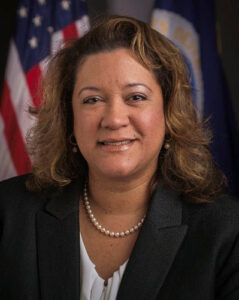Barbara Rater, Director of the Census and Survey Division at USDA’s National Agricultural Statistics Service (NASS), is at the forefront of data collection processes and initiatives. With extensive experience and diverse background, she shares her perspectives on the challenges and opportunities in the field of agricultural statistics and offers insights into her role in shaping policies and programs.
Q: Tell us about your role as Director of the Census and Survey Division at NASS and the key initiatives you’ve led to ensure the quality of agricultural statistics data collection processes. How have NASDA enumerators contributed to these efforts?
As the Director of the Census and Survey Division at NASS, I oversee the data collection process for national surveys and the Census of Agriculture, managing a hefty workload that includes producing over 400 reports annually. My passion is to deliver timely, high-quality results essential for decision-makers to assess markets and policies and to improve performance and productivity. Throughout my 38-year career, I’ve deeply respected and admired the dedication of farmers, ranchers, and agribusiness professionals who provide our nation and the world with a safe and abundant food supply. Working closely with NASDA enumerators, we maintain data quality and shape policies to support producers. They are the frontline representatives of NASS with our customers – the farming community.
Q: How do you see the future of agricultural data collection evolving and its role in shaping agricultural policies and practices?
The future of agricultural data collection is poised for evolution, especially regarding its impact on shaping policies and practices. In contrast to other government entities, the most distinguishing and critical aspect of federal statistical agencies is their reliance on voluntary participation and engagement from farmers and ranchers. Given the time constraints faced by producers, there’s a continuous need to streamline data collection processes. Maintaining high-security standards while exploring faster, more convenient data collection methods is paramount. NASDA enumerators play pivotal roles in driving innovation to support rural prosperity reducing burdens on agricultural producers and facilitating the flow of essential information.
Q: Could you share any recent improvements or updates made to ARMS 3, including any new or different survey questions from the previous version? What insights or data does this aim to capture about agricultural practices and trends?
As the world’s population grows, we will need to produce more food. The traditional view of agriculture is shifting with new research, technological advances, and increased concentration in farming. Recent improvements to ARMS 3 are evolving to capture that information, and more importantly, are giving producers an opportunity to share their insights and shape their own futures. Our partnership with NASDA enumerators ensures the delivery of complete and accurate data that supports U.S. agriculture. Better data means better decisions.
Q: What do you consider the biggest challenges and opportunities in the field of agricultural statistics today, and how can organizations like NASDA address them?
Over the past 15 years, response rates to NASS surveys have declined while the demand for additional data products and services has increased, adding to respondent burden and strained relations. Rising demands on producers’ time and competing survey requests contribute to this strain. To address these challenges, we must leverage existing datasets whenever possible. NASDA plays a significant role in building and maintaining relationships with producers, reinforcing the importance of NASS’s mission to agriculture and rural communities. NASDA enumerators further build trust by reinforcing the rigorous security and confidentiality measures in data collection efforts. Top of Form
Q: What motivated you to pursue a career in agricultural statistics, and how do you envision the role of NASDA enumerators in the future of data collection?
My passion for agriculture and the importance of census and survey data stems from my upbringing in a military family. I experienced frequent relocation and witnessed firsthand the disparities in access to safe, abundant food and water across different countries. This instilled in me a desire to contribute to providing credible, reliable statistics to level the playing field in agriculture. NASDA enumerators are instrumental in this mission, ensuring accurate and timely information reaches the public. Some of my most cherished memories at NASS involve working with NASDA enumerators, who shared valuable knowledge about local agriculture and provided wisdom and guidance that have influenced my career. Looking ahead, I envision NASDA enumerators continuing to play a vital role in data collection and facilitating the availability of essential information for agricultural decision-making.
Q: Can you share any advice for aspiring leaders in the field of agricultural statistics?
One of my favorite parts of my job is working with NASDA enumerators and fellow USDA colleagues, who I regard as some of the most dedicated individuals in their field. My advice for aspiring leaders in agricultural statistics is to value collaboration and recognize the dedication of colleagues and enumerators. As statisticians, seeing the impact of the data collected by enumerators is incredibly rewarding. Remember that people reply on our data for critical decisions in business, policy and life. In February 2024, NASS released the results of the largest census effort in USDA history. As a leader, I look for ways to enhance productivity by planning and applying my knowledge and skills in every decision I make, striving for continuous improvement.

